Azure Kubernetes Service (AKS) is a managed Kubernetes cluster on Microsoft Azure cloud that can be used to quickly deploy Kubernetes clusters. Basic AKS clusters use horizontal Pod autoscaler, using metrics server in Kubernetes clusters to monitor Pod resource requirements. If applications need more resources, Pod count is automatically increased to meet demand. If worker node resources are also insufficient, worker node autoscaling is performed based on Virtual Machine Scale Sets (VMSS). When scaling worker nodes, new virtual machines need to be started behind the scenes, making resource scaling relatively slow. For this reason, Azure also introduced virtual node functionality, which can quickly create pods based on Azure Container Instances without using virtual machines, eliminating wait time and greatly improving cluster scaling efficiency.
Note: As of May 2020, only the East 2 region in Azure China has released Container Instances service, and AKS scaling to Container Instances through virtual nodes is not yet supported. This feature has been officially released in most overseas regions. For specific release status, please refer to Azure Container Instances resource availability in Azure regions. To perform the following experiments, an overseas Azure environment is required. We're using the East US region.
Basic Deployment
Application
The demo application source code is here:
https://github.com/xfsnow/container/blob/master/VirtualNodeScaling
The Kubernetes deployment configuration file nginx-vn.yaml uses the classic nginx application for demonstration. Besides basic container image configuration, it uses tolerations and affinity to optimize the use of VM nodes and virtual nodes.
tolerations:
- key: virtual-kubelet.io/provider
value: azure
operator: Equal
effect: NoSchedule
affinity:
nodeAffinity:
preferredDuringSchedulingIgnoredDuringExecution:
- weight: 1
preference:
matchExpressions:
- key: type
operator: NotIn
values:
- virtual-kubelet
Virtual nodes added to AKS clusters are tainted by default, so we need to explicitly specify which workloads should be scheduled to virtual nodes through ACI. The tolerations in the configuration file allow pods to be scheduled to virtual nodes, so that when scaling pods and VM node resources are insufficient, they can be created on virtual nodes.
nodeAffinity specifies preferences when creating new pods, while ignoring during runtime. The preference is for nodes whose labels don't contain the virtual-kubelet value for type, meaning new pods are preferentially placed on VM nodes, while during contraction, pods on virtual nodes are preferentially deleted.
Azure Resources
Use the console to create an AKS cluster with virtual nodes enabled.
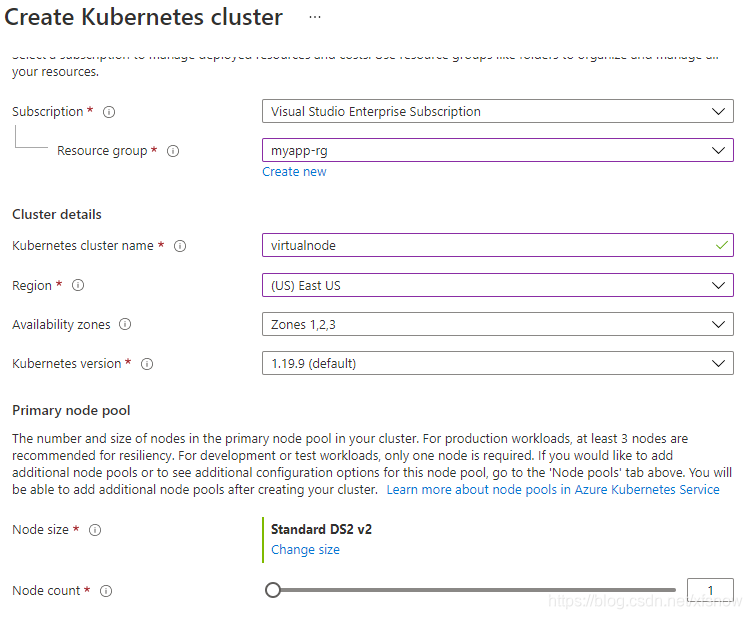
Select East US region and enter 1 for node count. Click the Next: Node pools button.
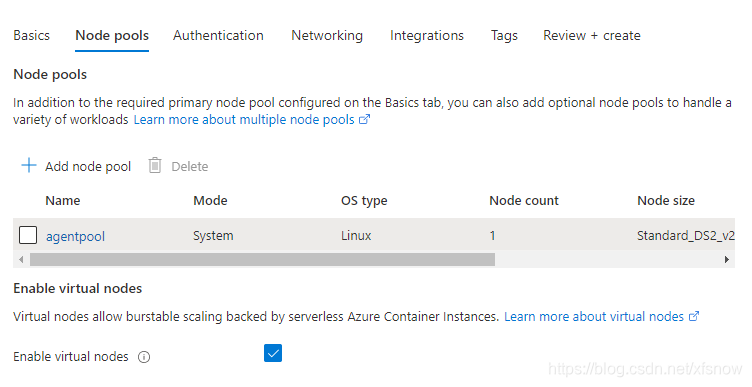
Check "Enable virtual nodes" - this is the key setting for enabling virtual nodes.
On the Networking page, only Azure CNI can be selected, Kubenet is no longer supported. We also need to specify Cluster subnet and Virtual nodes subnet - use default values for these.
Use default values for other configuration pages, click Review + Create to create the cluster.
After creation, let's first look at Workloads:

The aci-connector-linux here is the pod used to connect to ACI.
If this pod doesn't show as Ready immediately after creating the AKS cluster, please wait patiently - it may take 20-30 minutes to become Ready.
Now look at VMSS:
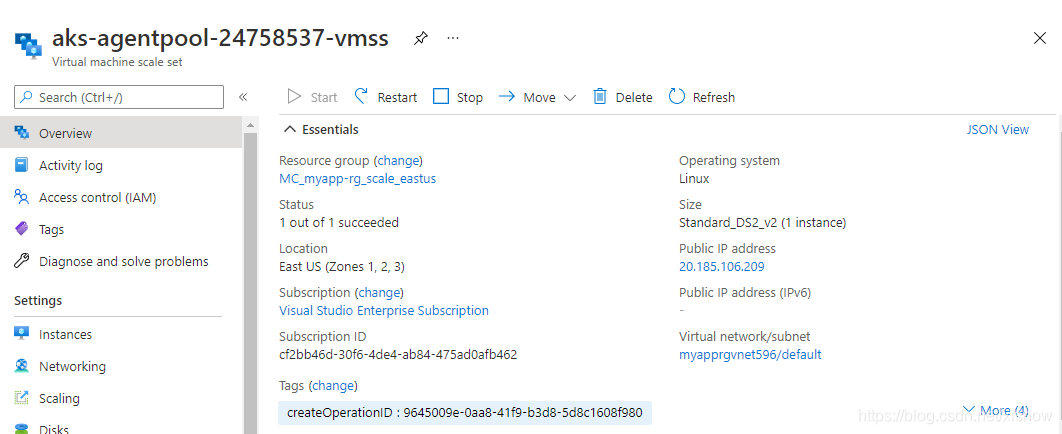
You can see there's 1 VM inside, running normally.
Click the Virtual network/subnet link to jump to the subnet where the VM is located.
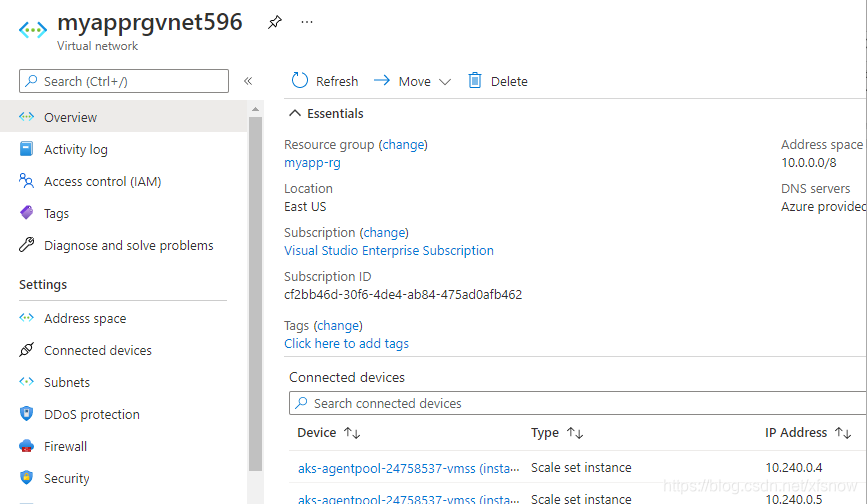
Click Subnets in the left navigation links to see that the AKS platform automatically created 2 subnets for us.
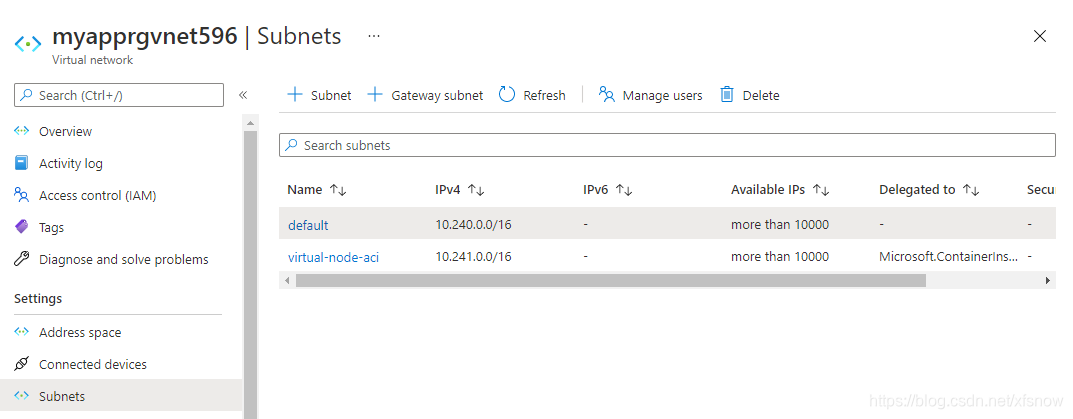
The "default" is the subnet where VM nodes are located, while the other "virtual-node-aci" is the subnet for future virtual node scaling.
Deploy Kubernetes
First connect to the Kubernetes cluster:
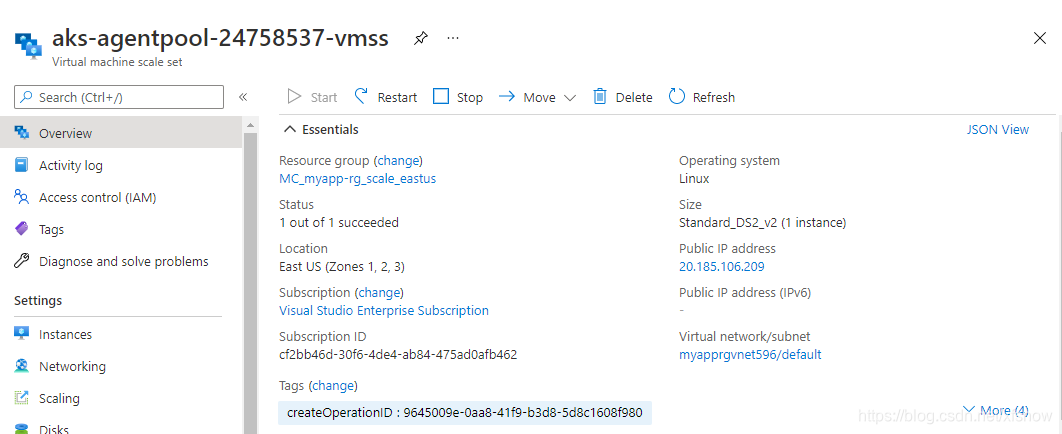
Then look at existing nodes:
kubectl get node
NAME STATUS ROLES AGE VERSION
aks-agentpool-34658330-vmss000000 Ready agent 10m v1.19.9
virtual-node-aci-linux Ready agent 9m35s v1.18.4-vk-azure-aci-v1.3.5
You can see aks-agentpool-34658330-vmss000000 is a regular virtual machine-based node, and virtual-node-aci-linux is the virtual node.
Create a namespace for all subsequent experiments:
kubectl create namespace virtualnode
namespace/virtualnode created
First, let's do a basic deployment of pods to virtual nodes:
kubectl apply -f helloworld-vn.yaml
deployment.apps/helloworld-vn created
Look at the pods:
kubectl get pods -o wide -n virtualnode
NAME READY STATUS RESTARTS AGE IP NODE NOMINATED NODE READINESS GATES
helloworld-vn-5749f58859-67vn6 0/1 Creating 0 21s <none> virtual-node-aci-linux <none> <none>
You can see it's deploying on the virtual node.
Look at details:
kubectl describe pod helloworld-vn-5749f58859-67vn6 -n virtualnode
Name: helloworld-vn-5749f58859-67vn6
Namespace: virtualnode
Priority: 0
Node: virtual-node-aci-linux/
Start Time: Tue, 11 May 2021 11:28:36 +0800
Labels: app=helloworld-vn
pod-template-hash=5749f58859
Annotations: <none>
Status: Running
IP: 10.241.0.4
IPs:
IP: 10.241.0.4
Controlled By: ReplicaSet/helloworld-vn-5749f58859
Containers:
helloworld-vn:
Container ID: aci://6ee343c40cb742b912ce86084cb73c5d0f9997dd55fa0b44290bb0c9b04370a4
Image: mcr.microsoft.com/azuredocs/aci-helloworld
Image ID:
Port: 80/TCP
Host Port: 0/TCP
State: Running
Started: Tue, 11 May 2021 11:28:36 +0800
Ready: True
Restart Count: 0
Environment: <none>
Mounts:
/var/run/secrets/kubernetes.io/serviceaccount from default-token-rzbnb (ro)
Conditions:
Type Status
Ready True
Initialized True
PodScheduled True
Volumes:
default-token-rzbnb:
Type: Secret (a volume populated by a Secret)
SecretName: default-token-rzbnb
Optional: false
QoS Class: BestEffort
Node-Selectors: beta.kubernetes.io/os=linux
kubernetes.io/role=agent
type=virtual-kubelet
Tolerations: node.kubernetes.io/not-ready:NoExecute op=Exists for 300s
node.kubernetes.io/unreachable:NoExecute op=Exists for 300s
virtual-kubelet.io/provider op=Exists
Events:
Type Reason Age From Message
---- ------ ---- ---- -------
Normal Scheduled 82s Successfully assigned virtualnode/helloworld-vn-5749f58859-67vn6 to virtual-node-aci-linux
Normal ProviderCreateSuccess 81s virtual-node-aci-linux/pod-controller Create pod in provider successfully
The first virtual node deployment took 82 seconds, which seems a bit slow. The time is mainly spent on two aspects: first, initially creating the ACI instance, and more time is spent pulling the mcr.microsoft.com/azuredocs/aci-helloworld image file and deploying.
Click to view container instances:

You can see there's now 1 container instance.
Finally, delete this deployment to clean up resources:
kubectl delete -f helloworld-vn.yaml
deployment.apps "helloworld-vn" deleted
Scaling Test
Mixed scaling of VM-based nodes and virtual nodes:
kubectl apply -f nginx-vn.yaml
deployment.apps/nginx-vn created
When deploying only 1 pod, it's preferentially deployed on the virtual machine node:
kubectl get pod -o wide --namespace virtualnode
NAME READY STATUS RESTARTS AGE IP NODE NOMINATED NODE READINESS GATES
nginx-vn-54d69f7df4-hxkkz 1/1 Running 0 23s 10.240.0.75 aks-agentpool-34658330-vmss000000 <none> <none>
First scale to 20 replicas:
kubectl scale deployment nginx-vn --replicas=20 -n virtualnode
deployment.apps/nginx-vn scaled
View pods:
kubectl get pod -o wide --namespace virtualnode
NAME READY STATUS RESTARTS AGE IP NODE NOMINATED NODE READINESS GATES
nginx-vn-54d69f7df4-4fr5g 1/1 Running 0 3m2s 10.241.0.19 virtual-node-aci-linux <none> <none>
nginx-vn-54d69f7df4-cg4jb 1/1 Running 0 3m2s 10.241.0.5 virtual-node-aci-linux <none> <none>
nginx-vn-54d69f7df4-cmj6d 1/1 Running 0 3m2s 10.241.0.7 virtual-node-aci-linux <none> <none>
nginx-vn-54d69f7df4-dljkw 1/1 Running 0 3m2s 10.241.0.16 virtual-node-aci-linux <none> <none>
nginx-vn-54d69f7df4-f25fb 1/1 Running 0 3m2s 10.241.0.8 virtual-node-aci-linux <none> <none>
nginx-vn-54d69f7df4-g6ps9 1/1 Running 0 3m2s 10.241.0.15 virtual-node-aci-linux <none> <none>
nginx-vn-54d69f7df4-h2dtq 1/1 Running 0 3m2s 10.240.0.82 aks-agentpool-34658330-vmss000000 <none> <none>
nginx-vn-54d69f7df4-hgkzc 1/1 Running 0 3m2s 10.241.0.14 virtual-node-aci-linux <none> <none>
nginx-vn-54d69f7df4-hxkkz 1/1 Running 0 7m53s 10.240.0.75 aks-agentpool-34658330-vmss000000 <none> <none>
nginx-vn-54d69f7df4-jf4h7 1/1 Running 0 3m2s 10.241.0.20 virtual-node-aci-linux <none> <none>
nginx-vn-54d69f7df4-mtjbn 1/1 Running 0 3m2s 10.241.0.9 virtual-node-aci-linux <none> <none>
nginx-vn-54d69f7df4-q9d5f 1/1 Running 0 3m2s 10.241.0.13 virtual-node-aci-linux <none> <none>
nginx-vn-54d69f7df4-qlf4l 1/1 Running 0 3m2s 10.241.0.18 virtual-node-aci-linux <none> <none>
nginx-vn-54d69f7df4-sb54f 1/1 Running 0 6m27s 10.241.0.4 virtual-node-aci-linux <none> <none>
nginx-vn-54d69f7df4-t4zmf 1/1 Running 0 3m2s 10.241.0.12 virtual-node-aci-linux <none> <none>
nginx-vn-54d69f7df4-xj95k 1/1 Running 0 3m2s 10.241.0.10 virtual-node-aci-linux <none> <none>
nginx-vn-54d69f7df4-xltlt 1/1 Running 0 3m2s 10.241.0.17 virtual-node-aci-linux <none> <none>
nginx-vn-54d69f7df4-xnhtc 1/1 Running 0 3m2s 10.240.0.109 aks-agentpool-34658330-vmss000000 <none> <none>
nginx-vn-54d69f7df4-zbzt5 1/1 Running 0 3m2s 10.241.0.6 virtual-node-aci-linux <none> <none>
nginx-vn-54d69f7df4-zphhk 1/1 Running 0 3m2s 10.241.0.11 virtual-node-aci-linux <none> <none>
Now scale back to 2 replicas:
kubectl scale deployment nginx-vn --replicas=2 -n virtualnode
deployment.apps/nginx-vn scaled
You can see that after scaling down, only pods on virtual machine nodes remain:
kubectl get pod -o wide --namespace virtualnode
NAME READY STATUS RESTARTS AGE IP NODE NOMINATED NODE READINESS GATES
nginx-vn-54d69f7df4-h2dtq 1/1 Running 0 5m18s 10.240.0.82 aks-agentpool-34658330-vmss000000 <none> <none>
nginx-vn-54d69f7df4-hxkkz 1/1 Running 0 10m 10.240.0.75 aks-agentpool-34658330-vmss000000 <none> <none>
Summary
Scaling to virtual nodes through ACI is indeed much faster than first scaling VMs based on VMSS and then scaling pods. However, the number of virtual nodes that can be scaled is also limited - unlimited scaling in a short time is not achievable. The recommended approach is to use AKS autoscaling as the foundation, combined with rapid scaling of virtual nodes to support burst scenarios. Use virtual nodes to handle burst demand first, giving AKS scaling time to expand. Scale both simultaneously, and once VMSS is scaled up, virtual nodes can be replaced. Moreover, VMSS scaling can theoretically provide larger-scale resources, offering more resources than using virtual nodes alone. This approach balances both performance and cost.